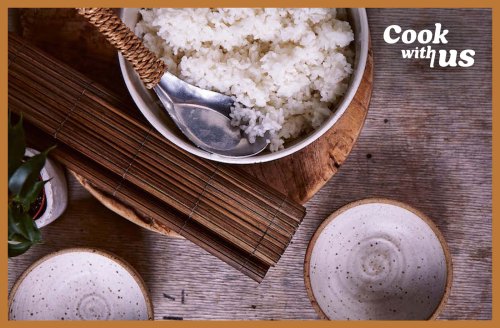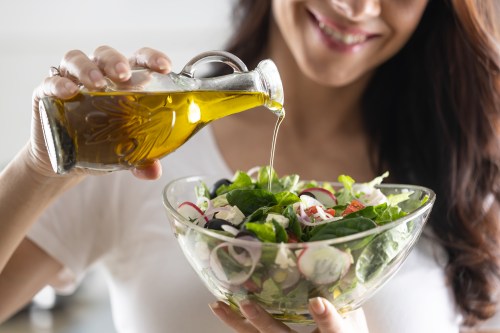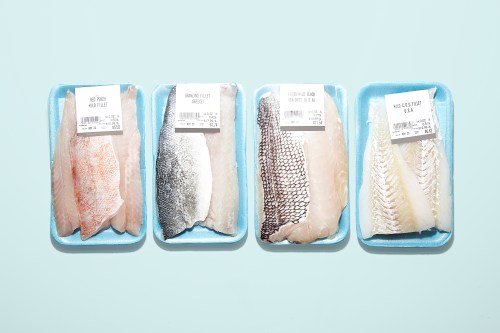Our editors independently select these products. Making a purchase through our links may earn Well+Good a commission
Want to start meal prepping more? Well+Good’s Prep School series does all the planning for you. Each month, we’ll focus on a different eating style, with four weeks of different delicious plans to try at home. All April, we’re focusing on plant-based eating, with each week focusing on a different type of cuisine. This week, the theme is Asian-inspired meals.
If you’re used to meat-centric meals but are trying to adapt to a more veggie-forward way of eating, cooking Asian-inspired meals is a good place to start. While Asian cuisine of course varies by region, the majority of dishes across the board are vegan-friendly, or can easily be made vegan with a simple substitute or two.
One expert on plant-based Asian-inspired cooking is Tim Anderson, whose gorgeous book Vegan Japaneasy came out last month. “Japanese dishes are often plant-based to begin with, since meat and milk were used so sparingly throughout much of Japanese history, and most of Japan’s oh-so satisfying seasonings are based on naturally vegan fermented soybean and rice products,” Anderson writes. A sampling of a few of the meal ideas you’ll find in his book: sweet miso-roasted beetroot, sweetcorn curry croquettes, ramen salad, and cauliflower katsu curry.
If you want to eat healthy Japanese-inspired meals all week, Anderson recommends prepping two key components in advance: white rice and wafu dressing (aka sweet onion and ginger dressing). “Both are extremely versatile,” Anderson says. “Rice may sound boring but it’s essential, and I think there are a lot of people who find it intimidating. It doesn’t have to be.” Here, he gives his expert intel on the right way to make restaurant-quality flurry white rice at home, his all-star wafu dressing recipe, and five ways to remix them to eat later in the week.
Keep reading for everything you need to master a week’s worth of easy, vegan Asian meals.
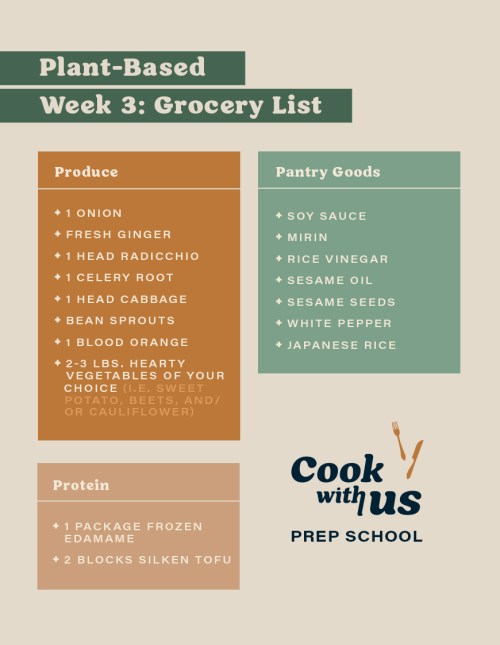
Produce
- 1 onion
- Fresh ginger
- 1 head radicchio
- 1 celery root
- 1 head cabbage
- Bean sprouts
- 2-3 lbs. hearty vegetables of your choice (i.e. sweet potato, beets, and/or cauliflower; enough to make three cups)
- 1 blood orange
Protein
- 1 package frozen edamame
- 2 blocks silken tofu
Pantry goods
What you’ll need from your own pantry/fridge:
The 2 recipes to cook on Sunday for a week’s worth of healthy Japanese-inspired food:
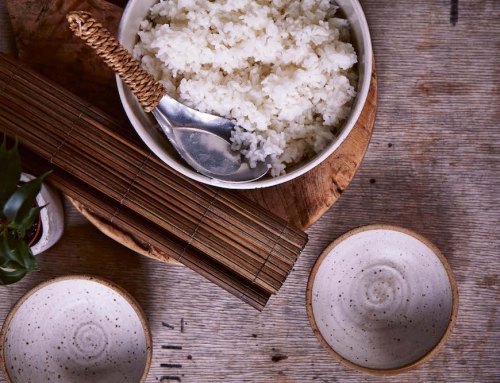
Recipe 1: Japanese white rice
Meal prep tip: “A while back on Twitter someone posed the question ‘what’s the one thing in cooking you always screw up?’ and numerous, skilled, professional chefs responded: rice,” Anderson says. Here, he shares how to do it up right. The below recipes makes four servings, which will be used for four different meals later in the week.
Yields 4 servings
Ingredients
1.5 cups Japanese rice
1. Measure out the rice into a pan and wash it.
2. Fill the pan with water. Swish the grains around and massage them gently, then drain the water out and repeat this process three or four times. This is to rinse off excess starch, which makes the rice pasty. (That starch is basically rice flour, so when it cooks it forms a kind of sticky glue.)
3. Pour two cups water into the pan and swirl it around a bit so the grains redistribute and settle in an even layer. If you have time, let the rice soak for 15 to 30 minutes, which will help them cook more evenly, but if you can’t wait, don’t worry—unsoaked rice will still be good.
4. Place the pan on a high heat with the lid off and bring to the boil. Place the lid on the pan and turn the heat way down—maybe not all the way down, because the rice should still be bubbling away, but it should be pretty low. As the rice cooks you should be able to hear it ticking away and see some steam escaping from the lid, so if this isn’t happening, turn the heat up a tiny bit. Set a timer for 15 minutes, then leave it to steam. Avoid the urge to remove the lid to check on the rice—it will be fine!
5. When the timer is up, turn off the heat, and fluff the rice with chopsticks or a fork, using a slice-and-fold motion rather than a dig-and-scoop motion so you don’t smash the grains. Put the lid back on the pan and wait another 5 to 10 minutes to the residual steam continues to soften the grains and loosen the stuck rice from the bottom of the pan. Finally, give the rice another gentle fluffing.
6. Store the rice in a microwaveable container. It will keep in the fridge for five days. One note about serving: While it’s 100 percent okay to reheat white rice, Anderson says it isn’t a good idea to let lukewarm rice sit out too long because bad bacteria can start to form. So make sure when you reheat it, you’re serving it hot!
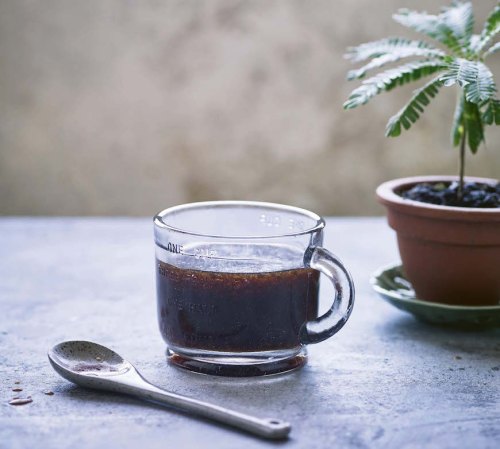
Recipe 2: Wafu dressing
Meal prep tip: “This dressing, whose name means ‘Japanese style,’ is perhaps the most ubiquitous salad dressing in Japan, and something everybody should have in their culinary repertoire because it’s just so delicious—and so easy,” Anderson says. “It’s great on a salad, of course, which can then be paired with rice, miso soup and another simple, small dish for a full Japanese dinner, but it also makes a great marinade, especially for grilled veggies.” The recipe below makes one-and-a-half cups, or 12 two-tablespoon servings. Enjoy one with veggies for dinner on Sunday. Three servings will be used in other recipes later in the week. This allows for a bit leftover, so you’ll be able to use it liberally on other dishes you make for yourself.
Yields 12 servings
Ingredients
1/4 onion2 centimeters fresh ginger, peeled1/2 cup soy sauce1/2 cup mirin1/2 cup rice vinegar1 Tbsp sesame oil1 Tbsp sesame seeds
1. Finely grate the onion and ginger, and combine with all other ingredients. Stir to combine.
2. Ideally, let it sit for a half hour or so for all the flavors to come together. Alternatively, put everything in a food processor and whizz it up until the onion and ginger are broken down.
3. Keep in a jar in the fridge for up to a month.
Other foods to meal prep on Sunday:
Hearty vegetables: Chop and roast three cups of hearty vegetables (such as sweet potatoes, cauliflower, or beets) to be incorporated into four meals later in the week. Just toss them with olive oil, salt, and pepper, place them on a baking sheet, and put them in the oven. Store them in the refrigerator in a resealable container until ready to use.
Here’s how to use these recipes to make easy, plant-based Japanese dinners all week long:
monday dinner: Fridge drawer fried rice
Leftovers: 1 serving Japanese rice, one cup hearty vegetables
New ingredients: Salt, white pepper, 1/2 block silken tofu
“Fried rice works with just about any vegetable, so it’s a good meal to make when you want to clear out the fridge,” Anderson says. But he says the seasonings—added when you fry the rice on the stove—are key. He recommends using sesame oil, salt, soy sauce, white pepper, and a tiny bit of mirin. Round out the meal by adding one cup of the hearty veggies you meal prepped yesterday and tofu for protein.
Tuesday dinner: wafu salad
Leftovers: 2 Tbsp wafu dressing
New ingredients: Radicchio, blood orange, 1/2 block silken tofu
“Wafu dressing is one of the most addictive salad dressings on the planet and it tastes great on basically anything, but I quite like it with something bitter and something sweet,” Anderson says. To get this flavor combo, he enjoys it with radicchio (chicory) and blood orange, but says it tastes delicious simply with cabbage, too. Round out your meal by adding tofu for protein.
Wednesday dinner: bento
Leftovers: 1 serving Japanese rice, 1 cup hearty veggies
New ingredients: 1/2 cup edamame
Bento (single portions of rice, protein, and veggies packaged together) is a common lunch in Japan, but it works just as well for dinner, too. Just pair the rice with a protein (Anderson recommends edamame) and a serving of your prepped, hearty veggies.
thursday dinner: wafu vegetable “steak”
Leftovers: 2 Tbsp servings wafu dressing, 1 serving Japanese rice
New ingredients: Celery root, 1/2 cup edamame
“In addition to being a salad dressing, wafu dressing is also commonly paired with meat or fish, but it works equally well on any kind of substantial vegetable or tofu pan-fried or grilled like a steak,” Anderson says. He says cauliflower steak is an obvious choice, but highly recommends making celery root steak instead, drizzling the dressing on top. Make the celery root steak by cooking it in the oven at 400°F for 10 minutes. Serve with one serving of leftover Japanese rice and a serving of edamame, for protein.
friday dinner: donburi
Leftovers: 1 serving wafu dressing, 1 serving Japanese rice, 1 cup hearty vegetables
New ingredients: Cabbage, bean sprouts, 1/2 block silken tofu
In Japan, rice bowls are called “donburi,” and Anderson says that while usually they have meat or fish, hearty veggies, such as sweet potato, beets, and cauliflower, work just as well. “Use the wafu dressing as a sauce for the rice itself, then pile on your hearty vegetables, bean sprouts, ginger, and tofu,” he says.
Join Well+Good’s Cook With Us Facebook community for more healthy meal ideas. Plus, five staples every plant-based kitchen needs.
Sign Up for Our Daily Newsletter
Get all the latest in wellness, trends, food, fitness, beauty, and more delivered right to your inbox.
Got it, you've been added to our email list.
